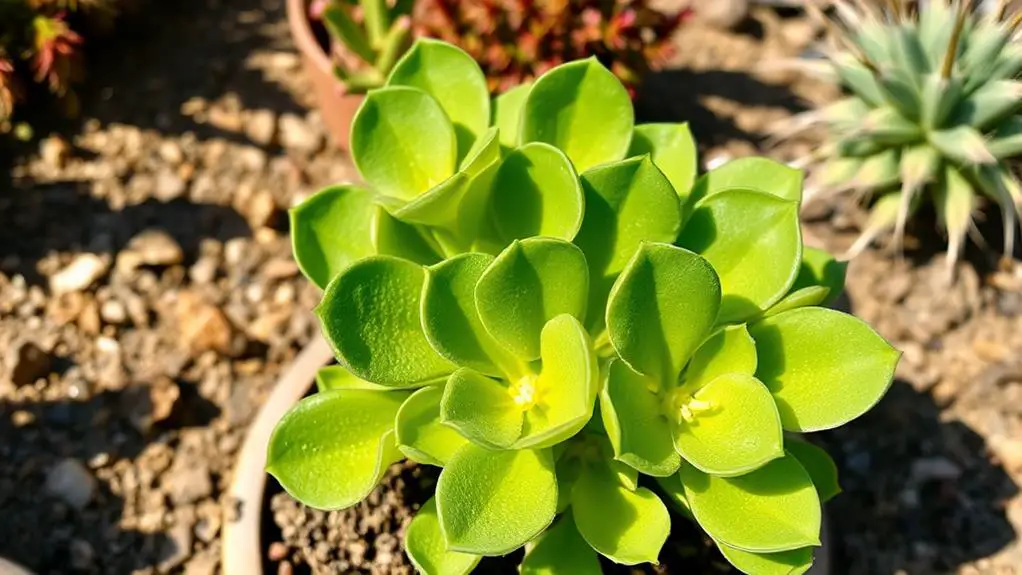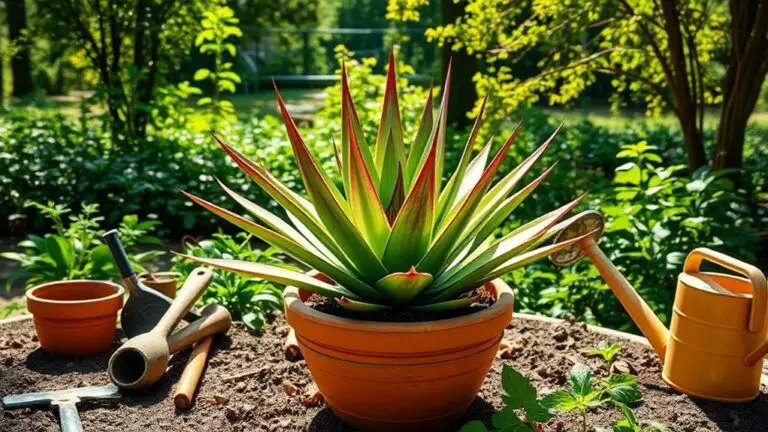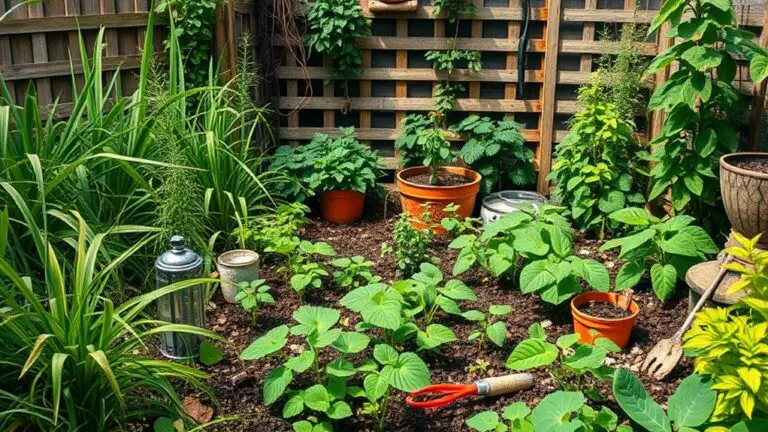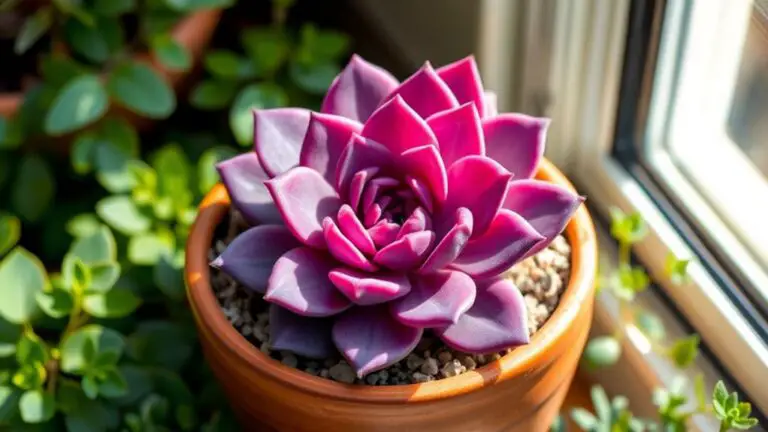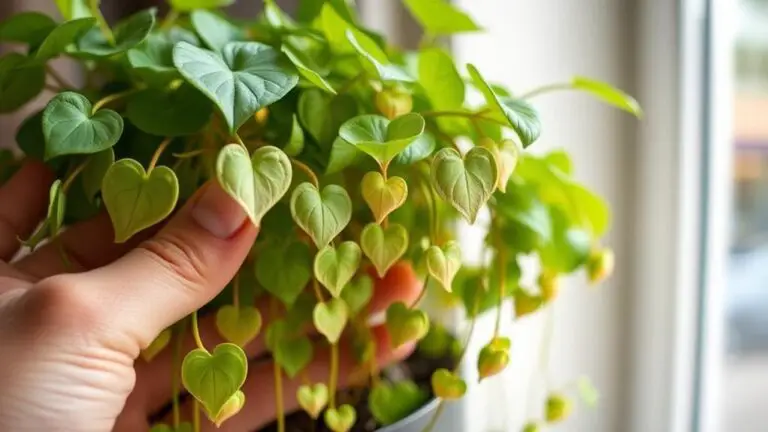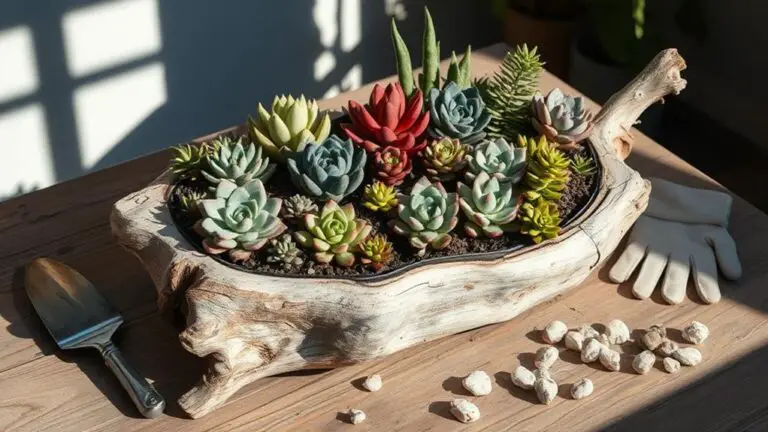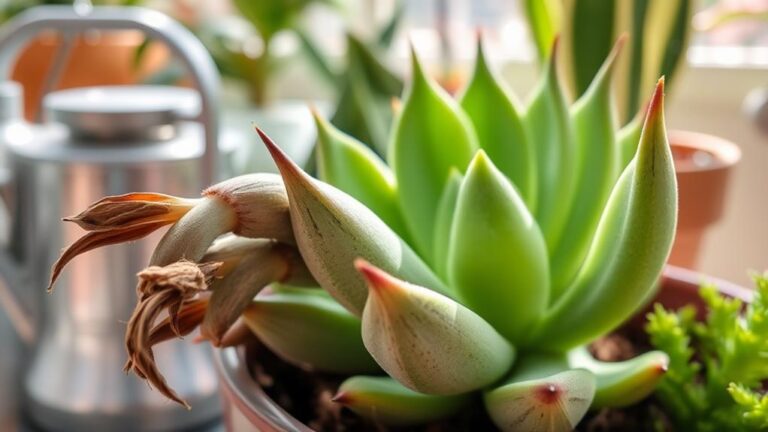7 Essential Steps to Care for Your Ice Plant Corpuscularia Lehmannii
Caring for your Ice Plant (Corpuscularia Lehmannii) involves more than just occasional watering. To guarantee its vibrant growth, you need to understand its specific requirements, starting with its light needs. This unique succulent thrives with 4-6 hours of indirect sunlight daily. But there's more to take into account, such as the type of soil and how often you should repot. Each step is vital for maintaining its health and beauty. Curious about how to master these steps and avoid common pitfalls? Let's explore the essential techniques to keep your Ice Plant flourishing.
Understanding Light Needs
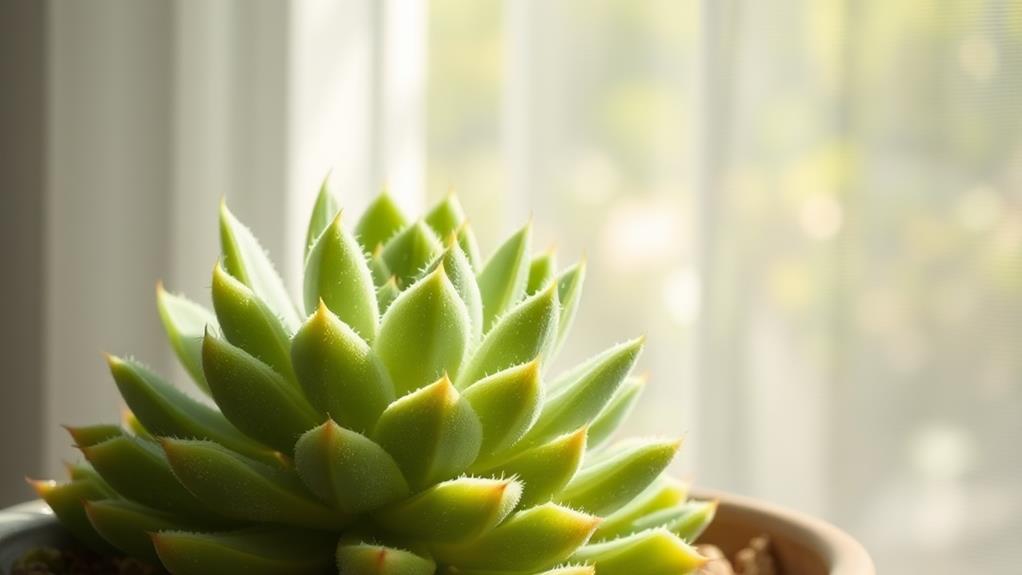
Understanding the light needs of ice plants is essential for their healthy growth. Ice plants thrive in bright sunlight and need 4-6 hours of indirect sunlight daily for peak growth.
If you're growing them indoors, place them where they'll get at least six hours of indirect light each day. Outdoors, they prefer sunny spots with well-draining soil and can tolerate full sun in warmer climates.
However, providing afternoon shade helps prevent sunburn and leaf damage during intense heat. Keep an eye on your plants and monitor their response to light.
Signs of distress, like wrinkling leaves, might mean excessive water loss or not enough light. Meeting these light needs guarantees your ice plants stay healthy and vibrant.
Proper Watering Techniques
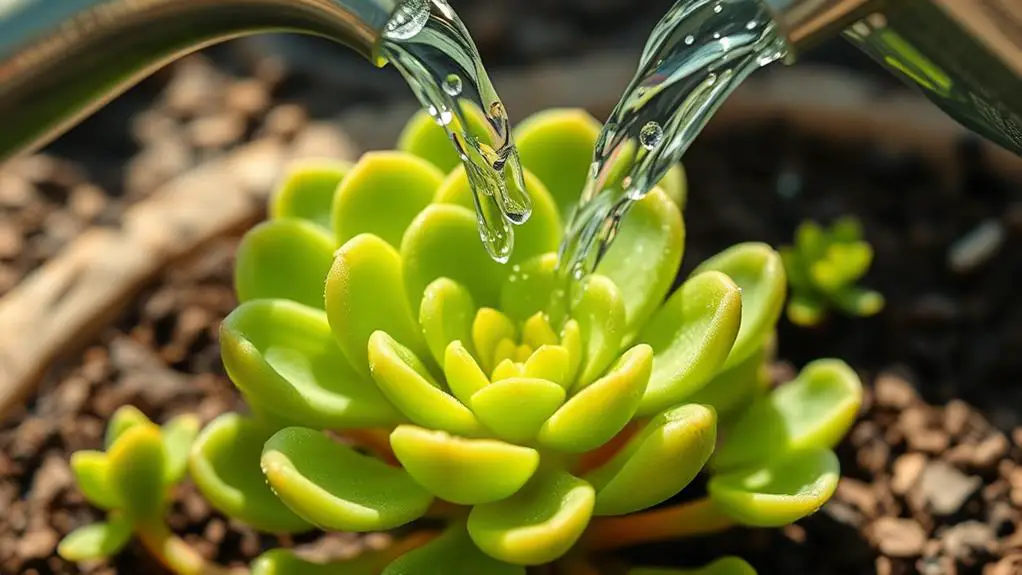
When it comes to watering your Ice Plant, using the soak and dry method is key.
Water thoroughly, then let the soil dry out completely before the next watering to avoid root rot.
In summer, check the soil regularly and water when the top inch is dry, but reduce watering in winter since the plant needs less moisture during its dormant phase.
Soak and Dry
The Ice Plant thrives best with the "soak and dry" watering method, which involves thoroughly watering the soil and allowing it to dry out completely before the next session.
For proper Ice Plant Care, water sparingly to avoid root rot. Always use well-draining soil and guarantee your pot has drainage holes.
Check the top inch of soil; it should be dry before watering again. In the summer, only water when the plant shows slight wilting.
During winter, reduce watering frequency to keep the plant from sitting in overly moist soil. Following these steps will help your succulent Care, making sure your Ice Plant stays healthy and vibrant.
Seasonal Watering Adjustments
Mastering the soak and dry method is just one aspect of effective Ice Plant care.
Seasonal watering adjustments are vital for your succulent's health. During summer, water your Ice Plant when the top inch of soil feels dry. Always guarantee good drainage to prevent root rot.
In winter, reduce watering frequency, letting the soil dry out completely between sessions. This mimics the plant's natural dormant phase and helps avoid overwatering.
Monitor your plant's needs:
- Growing season: Water more frequently in summer.
- Dormant phase: Let the soil dry out in winter.
- Environmental conditions: Adjust watering based on rainfall and humidity.
Always check soil moisture first, especially if leaves wilt in hot weather.
Your Ice Plant will thrive with these adjustments!
Soil and Fertilizer
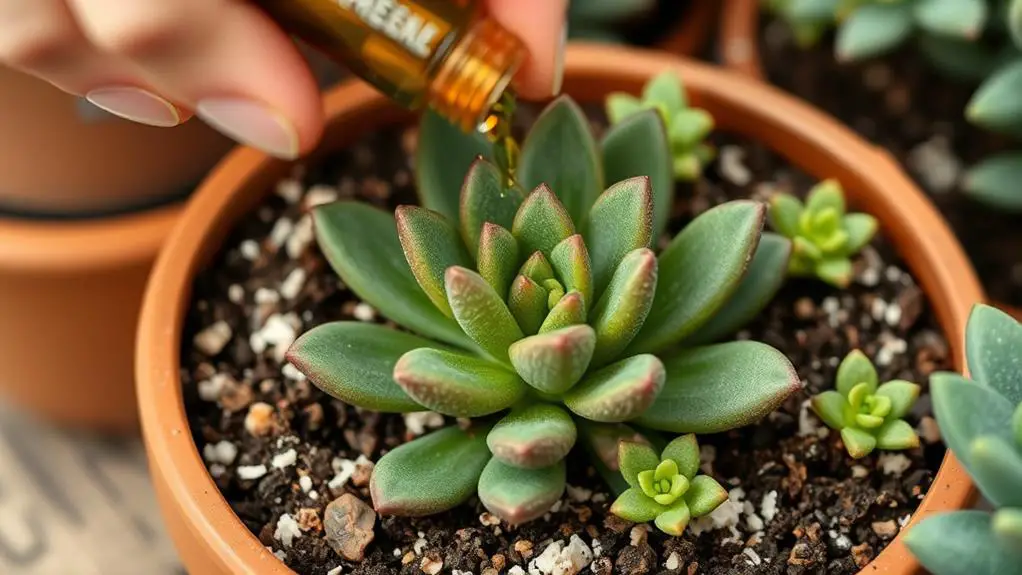
Caring for your Corpuscularia lehmannii, commonly known as the ice plant, starts with ensuring it has the right soil.
This plant thrives in well-draining soil, ideally a succulent potting mix, to prevent waterlogged roots. A blend of houseplant soil with perlite, coarse sand, or pumice enhances soil drainage and air circulation, promoting healthy root development.
Regularly check soil moisture levels, ensuring it dries out completely between waterings.
Fertilization is essential during the active growth period in spring and summer. Use a balanced, water-soluble fertilizer every 4-6 weeks.
Avoid fertilizing in winter, as the plant needs minimal nutrients then.
Ideal Temperature Conditions
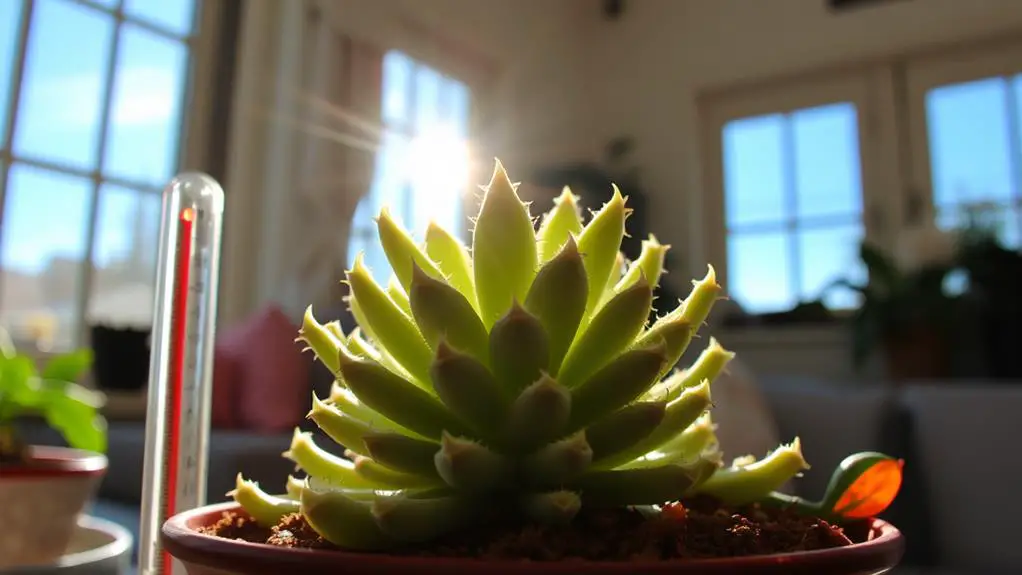
Wondering what temperatures best suit your ice plant? The ideal temperature range for Corpuscularia lehmannii is between 50°F (10°C) and 80°F (27°C). This range guarantees peak growth.
Here are some key points to take into account:
- USDA Hardiness Zones 9-11: This plant thrives in warm to hot environments. If you live in these zones, your ice plant will be quite happy.
- Tolerates temperatures as low as 20°F (-6°C): This makes it versatile for different climates, but avoid freezing temperatures below 23°F (-5°C) to prevent frost damage.
- Dormant period in winter: During colder months, the plant needs less water and cooler conditions.
Care for Corpuscularia lehmannii well, and it'll reward you with beautiful growth.
Propagation Methods
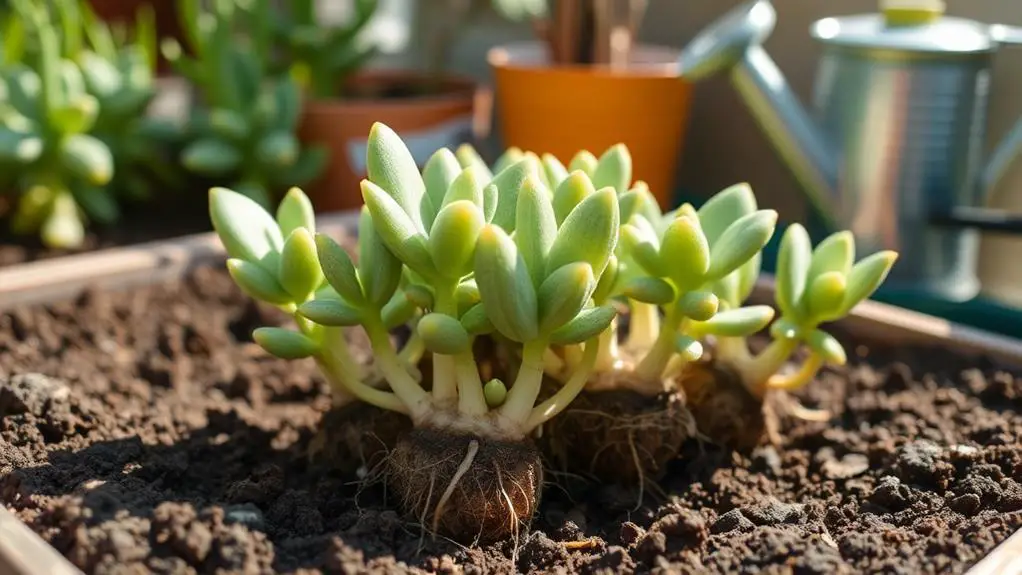
To propagate your Ice Plant, start by taking healthy stem cuttings with at least two nodes and let the cut ends dry and callus for a day or two.
If you prefer growing from seeds, sow them in a sandy, well-draining mix during spring when the weather is warm.
Remember to use sterile tools to cut the stems and guarantee you plant them in suitable soil for the best results.
Stem Cutting Techniques
One effective method for propagating Ice Plant (Corpuscularia lehmannii) is through stem cuttings. Follow these steps to guarantee successful propagation:
- Select healthy stems: Choose stems with at least two nodes. Cut them using sterile tools to prevent infection.
- Prepare the cuttings: Allow the cut ends to dry and callus for 1-2 days. This step is essential to prevent rot and promote healing.
- Plant in well-draining soil: Place the cuttings in slightly moist, well-draining soil. Keep the soil slightly moist, but let it dry out completely between waterings.
Monitor root development closely. Under proper conditions of warmth and light, cuttings typically root within a few weeks.
You'll soon have thriving new Ice Plants!
Seed Sowing Guidelines
After mastering stem cutting techniques, another effective way to propagate Ice Plant (Corpuscularia lehmannii) is by sowing seeds. First, sow seeds in well-draining soil, like a cactus or succulent mix. Lightly cover them, guaranteeing they get indirect sunlight. Keep the soil consistently moist but avoid waterlogging; let the top inch dry out between watering. Maintain an optimum germination temperature between 60°F to 75°F. Avoid extreme temperatures. Once seedlings develop a few true leaves, thin seedlings to prevent overcrowding.
| Step | Action | Tips |
|---|---|---|
| 1. Select Soil | Use well-draining soil | Cactus or succulent mix is ideal |
| 2. Sow Seeds | Lightly cover seeds with soil | Guarantee they receive indirect sunlight |
| 3. Watering | Keep soil consistently moist | Avoid waterlogging |
| 4. Temperature | Maintain 60°F – 75°F | Avoid extreme heat or cold |
| 5. Thin Seedlings | Thin once true leaves appear | Prevent overcrowding for better growth |
Repotting Guidelines
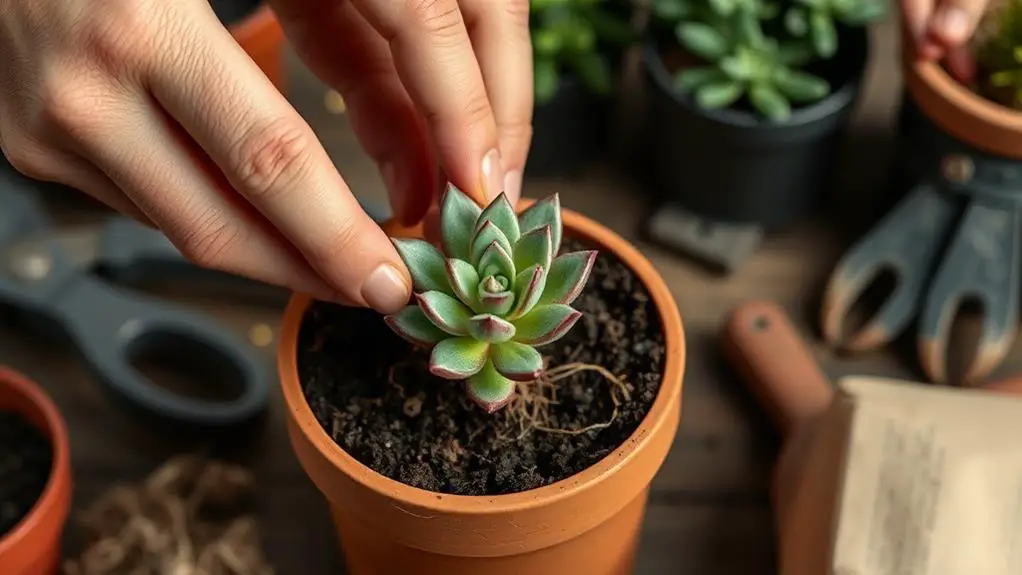
Wondering when it's time to repot your Ice Plant? You'll need to take into account repotting every 2-3 years or when you see roots growing out of the drainage holes.
Here's how to do it:
- Choose the right mix: Use a well-draining succulent or cactus potting mix to prevent root rot.
- Pick the perfect pot: Select a pot with drainage holes, ideally made of terracotta or ceramic, to help with air circulation.
- Handle with care: Gently handle the plant, making sure you don't damage its delicate stems during transplanting.
After repotting, allow your Ice Plant to acclimate for a few days before resuming regular watering.
This helps minimize stress on the roots and guarantees a smooth shift to its new home.
Addressing Common Issues
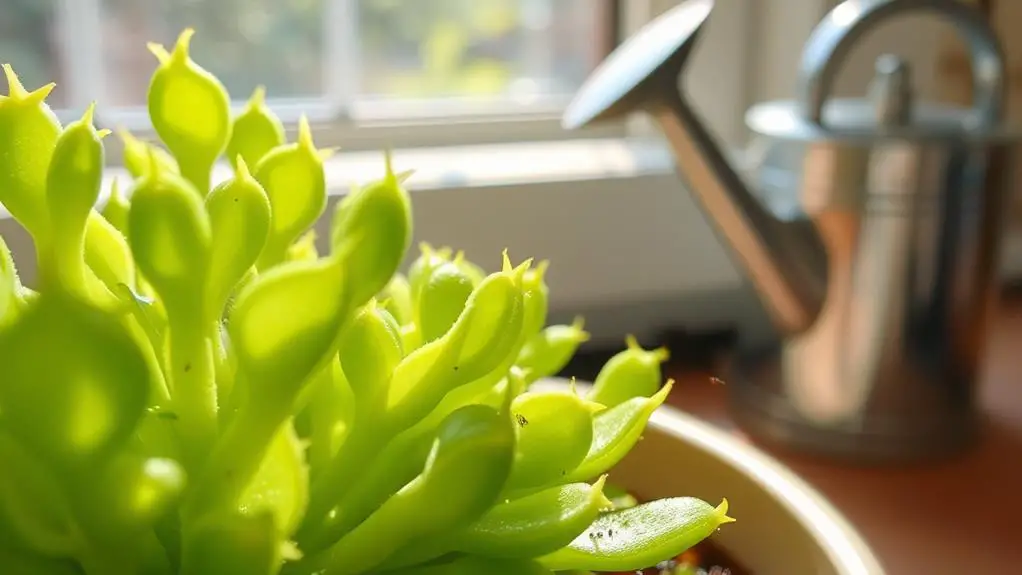
Making sure your Ice Plant thrives doesn't stop at repotting; addressing common issues promptly is equally important.
Overwatering is a frequent problem, leading to root rot. Let the soil dry completely between waterings to maintain plant health.
Too much direct sunlight can cause sunburn, so provide bright, indirect light. If you notice shriveled leaves, your plant might need more watering, especially in summer.
Regularly check for pests like mealybugs and aphids; mild insecticidal soap or rubbing alcohol works well.
Ice Plants are sensitive to frost, so bring them indoors or provide shelter during the winter months.
Frequently Asked Questions
How Do You Care for a Corpuscularia Lehmannii Plant?
To care for a Corpuscularia lehmannii plant, place it in bright, indirect light for 4-6 hours a day. Water sparingly, let soil dry completely, use well-draining mix, and fertilize occasionally during the growing season.
How to Take Care of an Ice Plant?
Place your ice plant in bright, indirect sunlight for 4-6 hours daily. Water sparingly, let the soil dry completely between waterings. Use well-draining soil, fertilize occasionally, and monitor for pests. This guarantees healthy growth and blooms.
Does Corpuscularia Lehmannii Like Sun or Shade?
Your Corpuscularia lehmannii prefers full sun, needing 4-6 hours of sunlight daily. It tolerates partial shade but may not bloom well. In hot climates, give it some afternoon shade to prevent leaf sunburn.
How to Care for Ice Plant Succulents Indoors?
Place your Ice Plant in bright, indirect sunlight for 4-6 hours daily. Use well-draining soil, water sparingly, and make certain temperatures stay between 50°F and 80°F. Check for pests regularly and treat promptly if needed.
Conclusion
Caring for your Ice Plant can be simple and rewarding with the right steps. By providing proper light, water, soil, and temperature, you'll help it thrive. Don't forget to fertilize, repot, and watch for pests. Propagation is easy, so you can share your plant with friends. Follow these tips, and you'll have a healthy, happy Ice Plant. Remember, gardening is a journey, and you're doing great. Keep going, and enjoy the process!

